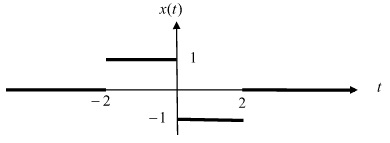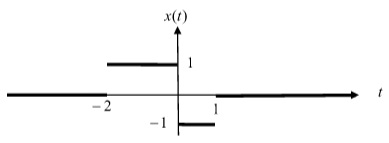Question 1:
Use the defining equation for Fourier Transform to evaluate the frequency-domain representations of the following three signals:
a) x(t) = e-2tu(t -3)
b) x(t) = Σm=0∞ (1/2)m δ(t-m)
c) x(t) as shown in the figure:

Question 2:
Use the equation describing the inverse Fourier Transform to determine the time-domain signals corresponding to the following two Fourier Transforms:
a) X(jω) = {cos(2ω), |ω| < π/4
{ 0 otherwise
b) X(jω) = 2jω/3 {u(ω + 3) - u (ω - 3)}
Question 3:
Use the tables of properties of Fourier Transforms and Basic Fourier transform pairs to find Fourier transforms of following three signals:
a) x(t) = sin(2πt)e-tu(t)
b) x(t) = d/dt (te-2t sin(t)u(t))
c) x(t) as shown in the figure:

Question 4:
Use the tables of properties of Fourier Transforms and Basic Fourier transform pairs to find inverse Fourier transforms of following two signals:
a) X(jω) = [4sin(2ω - 4)/2ω - 4] - [4sin(2ω + 4)/2ω + 4]
b) X(jω) = [(sin2(3ω)) cosω]/ω2
Question 5:
a) Find the frequency response and impulse response of the system having the output as y(t) and the input as x(t):
x(t) = e-1ut and y(t) = e-2t u(t) + e-3t u(t)
b) Determine the differential equation description for the system H(jω) = (jω - 1)/(ω2 + 4). Find impulse response of the system as well.
Question 6:
Consider the system shown in the following block diagram:

Input of the system is z(t) = 2cos(200πt) + 5cos(1000πt). This signal passes through a non-linear device (square) which has output of x(t) = z2t. The signal x(t) is filtered by an ideal band -pass filter which has cut-off frequencies of ω1 = 6.0π and ω2 = π
a) Draw the frequency spectrum of z(t), x(t) and y(t).
b) Using the frequency domain representation of y(t), evaluate y(t) in time domain.
c) Replace the ideal band-pass filter with a non-ideal filter to have the same output. Draw the frequency spectrum of this non-ideal filter.